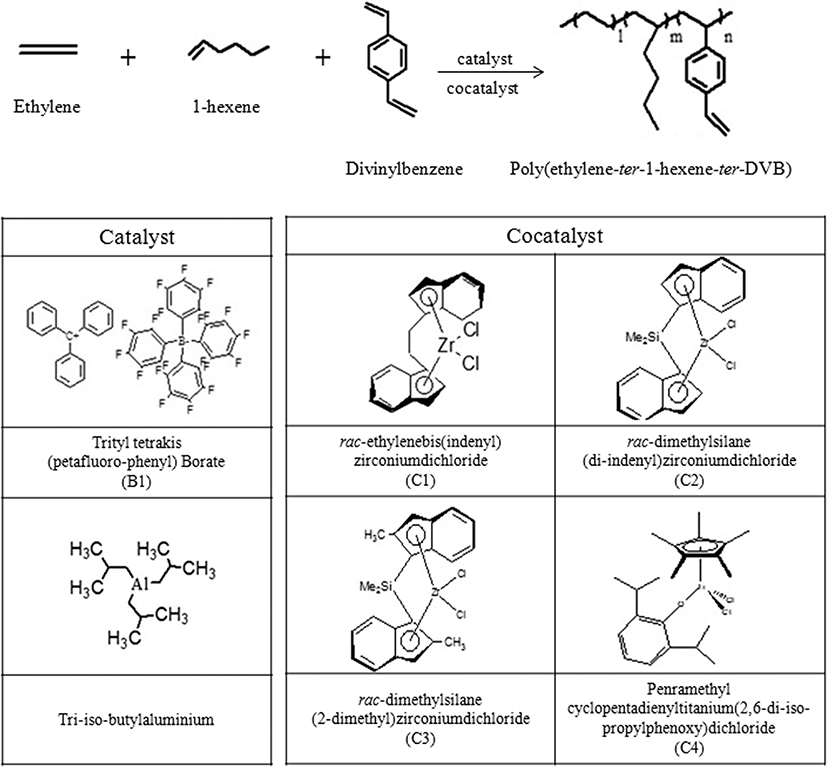Introduction
메탈로센 촉매는 전이금속이나 전이금속 할로겐 화합물에 시클로펜타디에닐(Cyclopentadienyl, Cp)기 등의 리간드가 배위결합한 화합물로 일반적으로 샌드위치 구조를 나타낸다. 불균일성인 Ziegler-Natta 촉매는 전이 금속 일부만이 활성점으로 작용하는데 반하여, 균일성인 메탈로센 촉매는 대부분의 전이 금속이 중합에 참가하여 더 높은 중합 활성을 나타내는 장점이 있다. 또한, Ziegler-Natta 촉매는 다수의 활성점이 존재하는 반면, 메탈로센 촉매는 일정 구조를 갖는 화합물이기 때문에 중합시 분자가 단일 활성점을 형성하고 모든 활성점이 동일한 특성을 나타낼 수 있게 한다. 이로 인하여 분자량 분포가 좁은 중합체나 균일한 조성의 공중합체를 제조할 수 있으며, 고분자 내 공단량체 함량을 조절하기에도 유용하다.1-3
1950년대에 메탈로센 촉매인 biscyclopentadienyl zirconium dichloride (Cp2TiCl2)가 Triethylaluminium (Et3Al)나 Diethyl-aluminium chloride (Et2AlCl) 공촉매와 함께 올레핀 중합이 가능하다고 보고되었으며,4,5 1980년 Kaminsky와 Sinn는 Cp2ZrCl2가 공촉매인 methyl aluminoxane (MAO)를 사용하여 에틸렌과 프로필렌 중합 시, 높은 촉매 활성도가 나타난다고 보고하였다.6
메탈로센 촉매를 이용한 공중합연구는 중합 조건에 따른 촉매 활성도, 중합체의 구조 및 조성, 중합체의 물성 변화 등 많은 연구그룹에 의하여 검토되어왔으나, 일반적으로 에틸렌, 프로필렌과 고급 α-올레핀, 디엔 단량체, 사이클로 올레핀, 스티렌 등을 이용한 이원공중합체에 관한 것이다.7-18 T. C. Chung 등은 메탈로센 촉매를 이용한 삼원공중합체를 합성한 바 있으며, poly(ethylene-ter-propylene-ter-divinylbenzene)과 poly(ethylene-ter-1-octene-ter-divinylbenzene)을 제조하여 촉매 활성도 및 분자량, 분자량 분포도 등을 비교하였다. 또한, 삼원공중합체의 divinylbenzene (DVB) 말단의 vinyl기에 styrene을 graft 시켜 NMR과 SEM 분석을 이용한 구조 분석을 확인하였다.19
비극성인 폴리올레핀은 다른 극성 고분자와의 상용성이 떨어지기 때문에 DVB와 같은 방향족 단량체의 vi-nyl관능기를 이용하여 기능성을 부여하기도 하는데, 이와 같은 관능기를 epoxy나 hydroxy, amine 등으로 치환하여 화학 중간체로써의 활용성을 증대시키기도 한다. 하지만, bulky하면서 2개의 관능기를 지닌 DVB를 도입한 선형 구조의 삼원공중합체의 합성은 매우 난이도가 높고 어렵다고 알려져 있으며, 특히 촉매의 종류에 따라 상이한 결과를 나타난다고 보고된 바 있다.20-24
본 연구에서는 다양한 구조의 메탈로센 촉매/Borate계 공촉매 시스템을 적용하여 관능성기를 가진 방향족 단량체를 포함한 유연poly(ethylene-ter-1-hexene-ter-divinylbenzene)을 합성하였고, 촉매 활성도와 삼원공중합체의 구조 및 조성, 결정화도, 분자량, 분자량 분포도 등을 비교하였다. 또한, 여러 가지 메탈로센 촉매/공촉매 시스템 조합 중 수율 및 촉매활성도가 가장 높은 삼원공중합체를 대상으로 DVB 말단의 비닐기에 에폭시화를 시도하여 새로운 기능성 삼원공중합체의 합성 가능성을 확인하였다.
Experimental
모든 중합 및 정제 과정은 질소 분위기 하에서 행하여 졌으며, 수분에 민감한 촉매는 외부와 차단된 글로브 박스 내에서 취급하였다. 반응계에는 molecular sieve (4Å)와 산화망가니즈 (II) 컬럼을 통과시켜 수분과 산소를 제거한 고순도의 질소가스(대명가스)를 투입하였다. 삼원공중합체의 구성 단량체로는 에틸렌(대명가스), 1-hexene (Aldrich 97%), divinyl-benzene (Aldrich, Alpha 80%, DVB)을 사용하였다. DVB는 5% NaOH 염기성 수용액을 이용한 세척을 통해 단량체에 함유되어 있는 중합 금지제를 제거한 뒤, 감압 증류하여 사용하였다.25 용매는 톨루엔(SAMCHUN, 99.5%)과 n-hexane (SAMCHUN, 99.5%)을 사용하였는데, 톨루엔의 경우 Na/benzophenone을 넣은 후, 증류 장치를 이용하여 정제를 하였다. 메탈로센 촉매는 Aldrich사의 rac-Et(Ind)2ZrCl2, rac-SiMe2(Ind)2ZrCl2, rac-SiMe2(2-Me-Ind)2ZrCl2와 Tokyo Metro-politan University의 Kotohiro Nomura 교수 연구실에서 제공받은 half metallocene 촉매인 (C5Me5)TiCl2[O-2, 6-iPr2(C6H3)]를 사용하였다. 촉매를 활성시키기 위한 공촉매로는 Tosoh 사의 Tri-iso-butylaluminium (TIBA)와 Aldrich사의 trityltetrakis pentafluorophenyl borate와 diethylanilium tetrakis(pentafluoro-phenyl)borate 를 이용하였다. 에폭시화 연구에서는 Aldrich 사의 m-chlorperbenzoic acid (이하 m-CPBA)를 산화제로 사용하였다.
분자량 및 분자량 분포도를 측정하기 위해 Polymer Laboratories사의 PL-GPC210모델인 High-Temperature Gel Permeation Chromatography (HT-GPC)를 사용하였으며, 이 때 용매는 1,2,4-trichlorobenzene (TCB)를 사용하였고 유속은 1 cm3/min로 하여 140°C에서 측정하였다. 비중 측정기는 ALFA MIRAGE 사의 MD-300S 모델을 이용하였으며, 1 g 미만의 시편을 5번씩 측정하여 평균치를 g/cm3 단위로 나타내었다. 삼원공중합체의 구조를 파악하기 위해 Bruker사의 AVANCE 500 MHz모델인 1H NMR을 사용하여 50°C에서 CDCl3 용매에 poly(ethylene-ter-1-hexene-ter-divinylbenzene) 삼원공중합체를 용해시켜 분석하였고, 에폭시화 여부를 확인하기 위하여 Thermo Nicolet 사의 Nexus 모델인 FT-IR을 활용하였다. 또한, 결정화도를 측정하기 위해 Rigaku사의 D/MAX-2200V 모델인 Wide Angle X-ray Scattering (WAXS)을 이용하였고, 2θ가 3-40° 범위에서 2°/min의 속도로 측정하였다.
중합 과정은 다음과 같다. 50°C의 300 mL 반응기에 톨루엔 100 mL를 넣고 High α-올레핀인 1-hexene을 주입한 뒤 DVB를 투입한다. 단량체들이 충분히 잘 섞이도록 500 rpm으로 10 분간 교반한 후 공촉매와 촉매를 주입한다. 이어서 에틸렌 가스를 59.6 psi으로 투입시키면서 중합을 실시한다. 중합이 완료되면 메탄올/HCl수용액에 석출 시킨 뒤 진공오븐에서 8시간 동안 건조시킨 후, 속실렛 장치를 이용하여 n-hexane으로 추출하고 건조시킴으로써 n-hexane에 완전히 녹는 정제된 비가교 형태의 유연 삼원공중합체를 최종적으로 얻을 수 있다.
Results and Discussion
메탈로센 촉매는 촉매의 구조에 따라 형성되는 고분자의 형태와 특성이 변한다고 알려져 있다. 따라서 본 연구에서는 ethyl기로 다리 결합되어 있는 rac-Et(Ind)2ZrCl2 (이하 C1) 촉매와 silane기로 다리 결합되어 있는 rac-SiMe2(Ind)2ZrCl2 (이하 C2), rac-SiMe2(2-Me-Ind)2ZrCl2 (이하 C3), 비다리 구조의 half metallocene 촉매인 (C5Me5)TiCl2[O-2, 6-iPr2(C6H3)] (이하 C4) 촉매, 총 4종의 촉매를 이용하여 ethylene, 1-hexene 및 divinylbenzene으로 이루어진 poly(ethylene-ter-1-hexene-ter-divinylbenzene)를 합성하였다(Figure 1). 메탈로센 촉매를 활성화시켜줄 수 있는 공촉매는 tri-iso-butylaluminium와 trityl-tetrakis pentafluorophenyl borate (이하 B1)를 사용하였다.
촉매 활성도는 Table 1과 Figure 2에서 나타낸 바와 같이, C1촉매가 6632로 가장 높게 나타났으며, C4 촉매가 가장 낮게 나타났다. C4 촉매는 비다리 구조의 특성으로 bulky DVB가 선택적으로 더 많이 삽입되고 이로 인하여 ethylene의 삽입이 방해되어 상대적으로 촉매 활성도가 매우 낮게 나타난 것으로 판단된다. C2, C3 촉매의 경우도 C1 촉매에 비하여 briged되어 있는 silane기가 활성점 주위의 결합각을 넓혀 줌에 따라 bulky한 DVB가 상대적으로 더 많이 삽입된 것이 촉매 활성도에 부정적인 영향을 미친 것으로 판단된다.

Table 1에 정리한 바와 같이 C1을 이용하여 합성한 삼원공중합체에 도입된 ethylene, 1-hexene, DVB의 조성비는 각각 83.3%, 16.3%, 0.4%이며, C2를 이용한 경우는 81.3%, 17.7%, 1.1% 이었다. 마찬가지로 C3를 이용한 삼원공중합체의 경우는 82.0%, 17.4%, 0.6%, C4를 이용한 삼원공중합체의 경우는 50.8%, 40.8%, 8.4%로 나타났다.
C3 촉매를 이용한 삼원공중합체에서 ethylene 단량체의 조성비가 상대적으로 높게 나타나는 이유는 C3 촉매의 활성점 사이각이 좁은 특성으로 인하여 ethylene보다 구조가 큰 공단량체인 1-hexene 및 DVB의 도입이 상대적으로 적게 이루어졌기 때문으로 판단된다. 상대적으로 넓은 활성점 사이각을 가지고 있는 다리 구조의 C2 및 C3촉매를 이용한 삼원공중합체에 있어서는 C1 촉매의 경우보다 1-hexene 및 DVB의 도입 함량이 더 높게 나타났다. 특히, half metallocene 촉매인 C4를 이용하여 합성한 삼원공중합체의 경우는 고유의 비다리 구조 특성으로 활성점 사이각이 매우 커서 공단량체인 1-hexene 및 DVB의 도입 함량이 거의 50%에 가까운 결과를 보여주 었다.
Figure 3은 다양한 메탈로센 촉매를 이용하여 합성한 앞서의 4가지 종류의 삼원공중합체의 WAXS 분석 결과 데이터 이다. 각각의 그래프에서는 3개의 큰 peak가 관찰되는데 19.5-20.0° 부근에서 amorphous peak, 21.8°와 24.3°에서는 crystallization peak가 확인되었다. 피크 분석 결과 C1, C2, C3 및 C4 촉매를 이용하여 합성한 삼원공중합체들의 결정화도는 각각 30.31%, 22.57%, 24.09% 및 11.49% 이었다. 특히, C4 촉매를 이용하여 합성한 삼원공중합체가 매우 낮은 결정화도를 보여 주었으며(Run 4), ethylene이 다른 삼원공중합체들 대비 많이 도입된 C1 촉매를 이용하여 합성한 삼원공중합체가 가장 높은 결정화도를 나타내는 것을 확인할 수 있었다(Run 1).

Figure 4는 가장 높은 촉매활성도와 수율을 보인 C1 촉매에 2종의 공촉매를 조합하여 poly(ethylene-ter-1-hexene-ter-divinylbenzne) 삼원공중합체를 합성하는 scheme이다. 공촉매로는 앞서의 trityl tetrakis(pentafluoro-phenyl)borate (이하 B1) 공촉매와 diethylanilium tetrakis(pentafluorophenyl)borate (이하 B2) 공촉매를 사용하였으며, 공통적으로 tri-iso-butyl-aluminium (TIBA) 공촉매를 적용하였다.

Table 2에서 상기의 메탈로센 촉매/공촉매 시스템을 이용한 삼원공중합의 촉매활성도 및 분자량 특성 등을 정리하였다. 촉매활성도는 B2 공촉매를 사용하여 합성한 삼원공중합의 경우가 B1 공촉매를 사용하여 합성한 삼원공중합 보다 더 높은 촉매활성도를 보여주었다. 이는 상대적으로 bulky한 B1 공촉매에 의한 입체방해 효과에 의해 B1 공촉매의 C1 촉매에 대한 접근성을 떨어뜨리고 이로 인해 촉매의 안정성을 떨어뜨리기 때문이라고 판단된다.
삼원공중합체의 조성은 B1 공촉매로 중합하였을 때 ethylene, 1-hexene 및 DVB의 조성비가 각각 84.0, 15.7 및 0.3% 이었다. 반면에 B2 공촉매를 사용한 경우에는 각각 83.3, 16.3 및 0.4% 이었다. B1 공촉매를 적용한 경우가 B2 공촉매를 적용한 삼원공중합체 대비하여 상대적으로 bulky한 공단량체인 1-hexene 및 DVB가 더 적게 도입되었음을 확인할 수 있는데, 이는 B1 공촉매가 B2 공촉매 대비 입체장애효과가 더 커서 분자구조가 커다란 2개의 공단량체의 접근성을 떨어뜨리기 때문에 일어난 현상이라고 할 수 있다.
Figure 5는 B1 및 B2 공촉매를 이용하여 각각 합성한 삼원공중합체의 1H NMR spectra이다. 두개의 스펙트럼에 공통적으로 1-2.5 ppm 까지는 ethylene과 1-hexene의 CH, CH2, CH3 peak가 강하게 나타나는 것을 알 수 있으며, divinylbenzene의 방향족 peak는 7.08 ppm과 7.22 ppm에서 나타났다. 또한 divinylbenzene 말단기의 이중결합 peak는 4.0-6.0 ppm에서 확인이 되었다. 상기의 분석 결과를 토대로 divinylbenzene이 성공적으로 도입된 삼원공중합체가 합성되었음을 알 수 있었다.
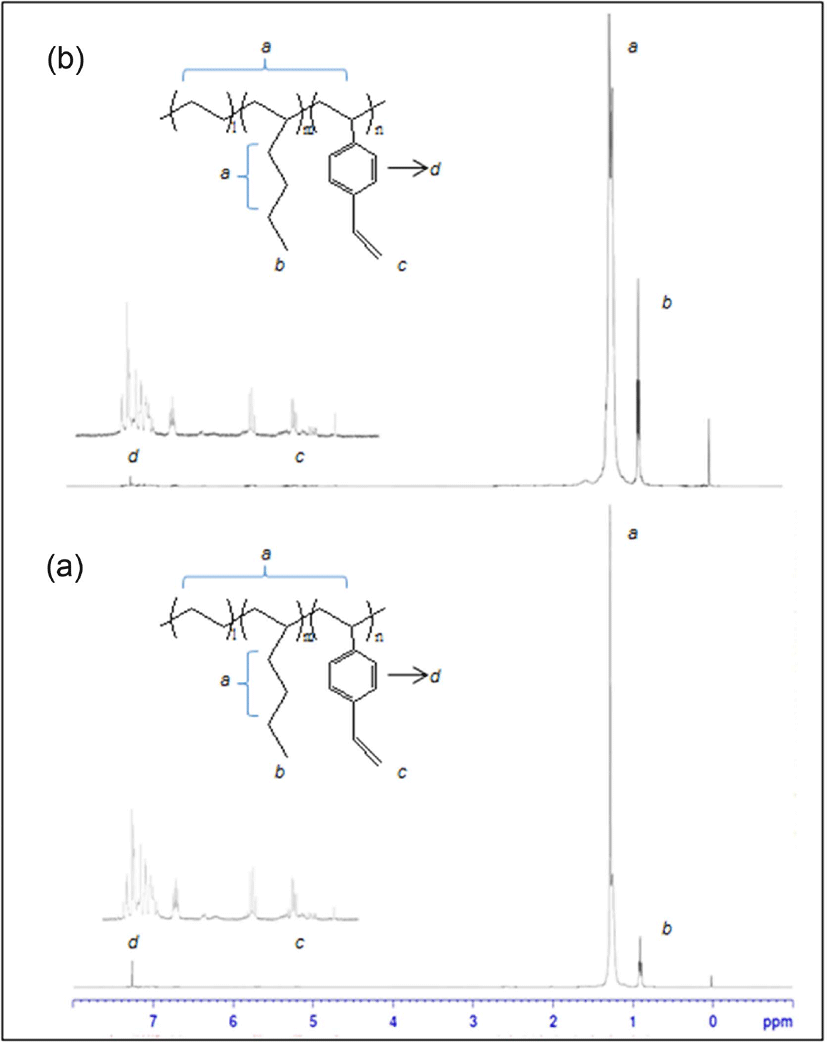
Run No. 6의 C1B2 조합의 메탈로센 촉매/공촉매 시스템으로 합성한 poly(ethylene-ter-1-hexene-ter-DVB) 말단에 있는 vinyl기를 epoxy기로 치환하는 연구를 진행하였다. 반응에 사용된 m-CPBA는 epoxidation에 일반적으로 쓰이는 peroxide계 산화제이며, 친전자체 역할을 한다. poly(ethylene-ter-1-hexene-ter-DVB) 말단의 vinyl기는 친핵제로 m-CPBA와 반응하기 때문에 중간체 없이 치환이 가능하다. 본 연구에서는 제조한 삼원공중합체에 기능성을 부여하기 위하여 Figure 6과 같이 삼원공중합체의 말단에 존재하는 vinyl기를 epoxy기로 치환하였다.
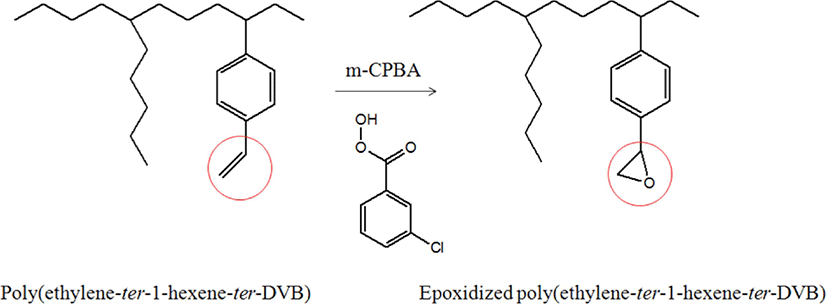
1H NMR 분석과 FT-IR 분석을 통하여 epoxy 기의 도입 여부를 확인하였다. Figure 7의 1H NMR spectra를 분석한 결과, Figure 7(a)에 나타난 바와 같이 4.8 ppm 에서 합성한 삼원공중합체의 vinyl기 피크를 확인하였고, Figure 7(b)에서는 2.3 ppm과 3.0 ppm 사이에서 epoxy기에 해당하는 CH 와 CH2 피크가 Figure 7(a)와 비교하여 눈에 띄게 커지는 것을 확인하였다.
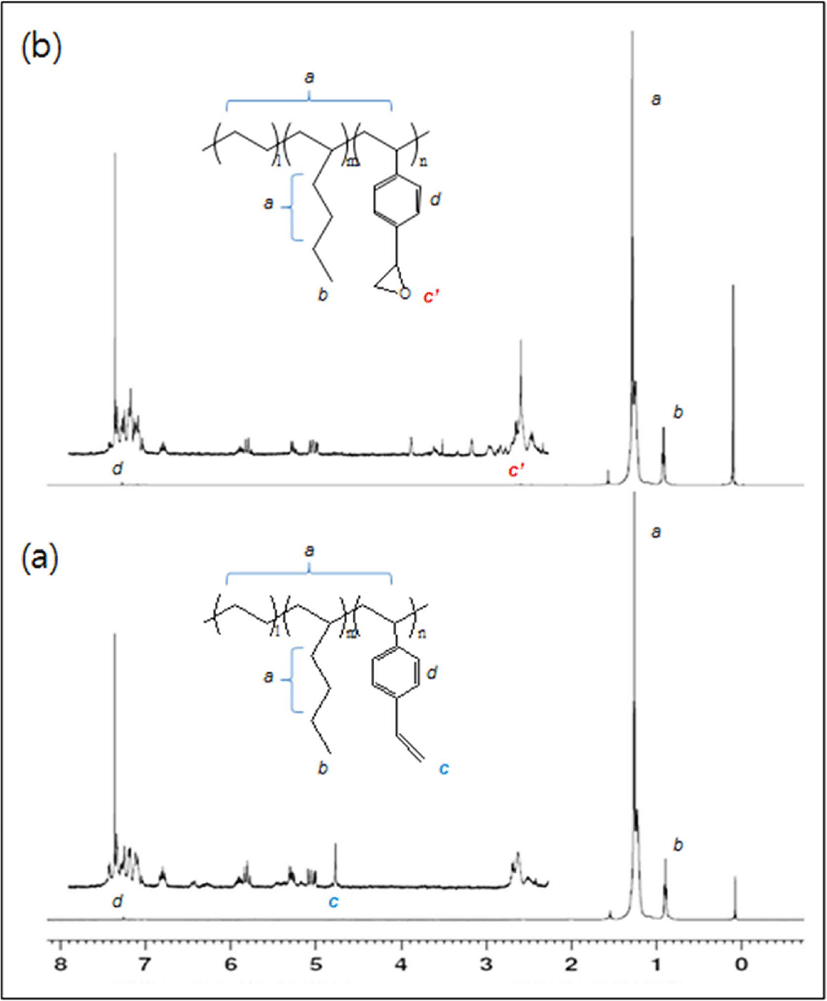
Figure 8의 IR spectra 분석 결과, 1638, 990 및 910 cm−1 파장대에서 삼원공중합체의 vinyl기에 해당하는 peak 가 확인되었고(Figure 7(a)), 에폭시로 치환한 삼원공중합체는 1260과 870 cm−1 파장대에서 epoxy ring의 신축진동에 의한 피크가 관찰되었다. 이것으로 C1B2 조합으로 합성한 삼원공중합체의 말단 vinyl기가 epoxy기로 성공적으로 치환된 것을 확인할 수 있었다.
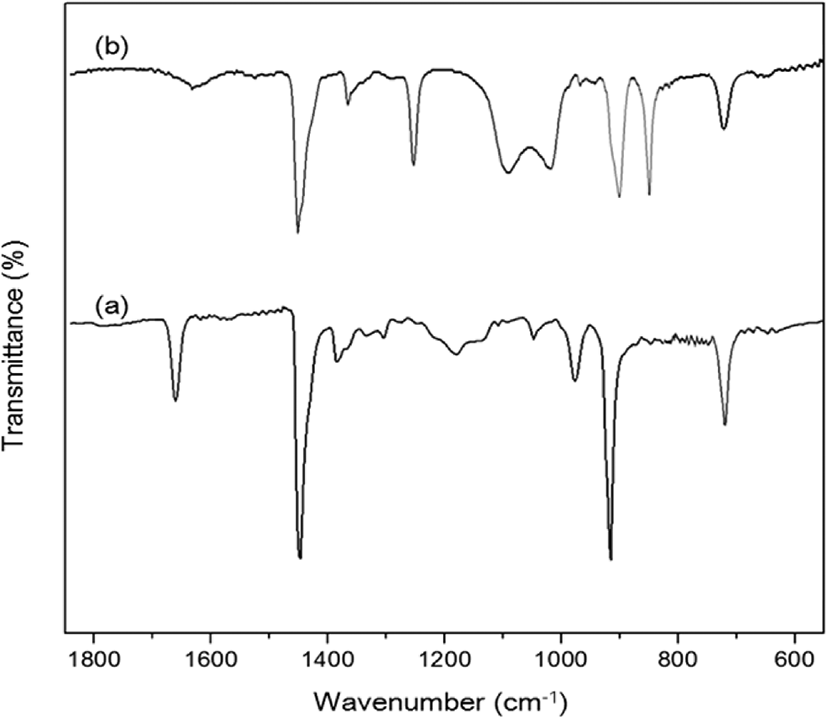
Conclusion
본 연구에서는 다양한 구조의 메탈로센 촉매 4종과 보레이트계 공촉매 2종을 조합하여 poly(ethylene-ter-1-hexene-ter-divinylbenzene) 삼원공중합체를 제조하였고, 수율 및 촉매활성도가 가장 높은 조합의 촉매/공촉매 시스템을 이용하여 합성한 유연 삼원공중합체의 에폭시화를 시도하였다. 메탈로센 촉매 4종에 대한 특성 비교 결과, C1 촉매가 가장 높은 촉매활성도와 수율을 나타냈으며, 이를 이용하여 합성한 삼원공중합체의 분자량 및 결정화도 또한 높게 나타났다. C2와 C3 촉매는 공통적으로 silane기가 bridge되어 있는 구조로 활성점 주위의 결합각이 넓고, C4 촉매는 비다리 구조이기 때문에 분자 구조가 ethylene 단량체 대비 큰 1-hexene 및 DVB의 삽입이 용이하다. 반면에 ethylene의 삽입은 상대적으로 감소될 수 있는데, 이것이 촉매활성도 및 결정화도를 감소시키는 원인으로 볼 수 있다. 공촉매 2종에 대한 비교 실험 결과에서도 더 작은 분자구조를 지니고 있는 B2 공촉매를 사용한 삼원공중합체의 촉매활성도 및 수율이 더 높게 나타나는 것이 확인되었다. C1B2 조합의 촉매 및 공촉매 시스템으로 합성한 삼원공중합체의 에폭시화 연구에서는 1H NMR 분석과 FT-IR 분석 결과를 통하여 vinyl기의 소멸과 epoxy기의 생성을 관찰하였다. 이를 통하여 삼원공중합체의 말단 vinyl기가 epoxy기로 성공적으로 치환되었음을 확인하였고 새로운 기능성 유연 공중합체를 제조할 수 있는 가능성을 확인 할 수 있었다.
